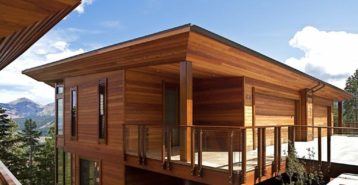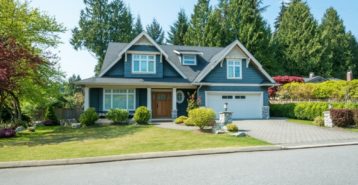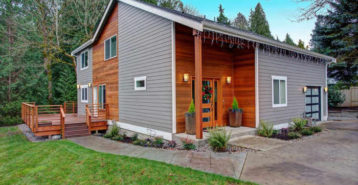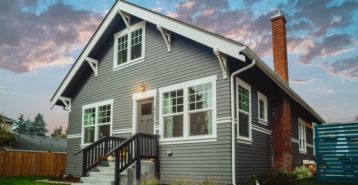Engineered Wood Siding Cost and Benefits
Engineered wood siding offers homeowners a cost-effective alternative to natural wood. Made with composite wood strands and resins, it provides the look of real wood with improved durability and lower maintenance needs. It’s also lighter and easier to install, which helps keep labor costs down.
On average, engineered wood siding costs $3 to $8 per square foot for materials or $7 to $15 per square foot installed, making it less expensive than traditional wood siding. With proper care, it typically lasts 20 to 30 years, while natural wood can last up to 50 years.
Engineered Wood Siding vs. Other Siding Types
Engineered wood is often compared to natural wood, fiber cement (Hardie Board), and vinyl siding. Each option comes with unique strengths and trade-offs.
| Siding Type | Installed Cost (per sq. ft.) | Lifespan | Maintenance Needs | Approximate ROI at Resale |
|---|---|---|---|---|
| Engineered Wood | $7 to $15 | 20 to 30 years | Low: rinse annually, occasional repainting | 70% |
| Natural Wood | $8 to $16 | 30 to 50 years | High: regular staining/painting required | 77% |
| Fiber Cement (Hardie Board) | $6 to $12 | 30 to 50 years | Moderate: repaint every 10 to 15 years | 68% to 75% |
| Vinyl | $3 to $7 | 20 to 40 years | Very low: soap and water cleaning | 67% |
Engineered Wood vs. Natural Wood
Engineered wood siding mimics the look of real wood while addressing many of its drawbacks. It resists splitting, cracking, and warping, and it is treated for rot and pest resistance. Natural wood, while beautiful and long-lasting, requires regular staining or painting and costs significantly more — $8 to $16 per square foot installed. Engineered wood is the more budget-friendly, low-maintenance choice, while natural wood remains the premium option for authenticity and maximum longevity.
Engineered Wood vs. Hardie Board (Fiber Cement)
Fiber cement siding, often known by the brand James Hardie, is one of engineered wood’s main competitors. Hardie Board typically costs $6 to $12 per square foot installed, which is slightly more expensive than engineered wood but offers exceptional fire resistance and up to 50 years of durability. Engineered wood is lighter, easier to install, and eco-friendlier since it uses wood byproducts. Homeowners looking for a balance of cost, natural look, and simpler installation may prefer engineered wood, while those prioritizing fire resistance and ultra-long lifespan may choose fiber cement.
Engineered Wood vs. Vinyl
Vinyl siding is the most affordable type of siding at $3 to $7 per square foot installed. It requires very little maintenance and lasts 20 to 40 years but does not provide the authentic look of wood. Engineered wood siding costs more but delivers a far more natural appearance, making it a strong mid-range option for homeowners who want curb appeal without paying premium natural wood prices.
Engineered Wood Siding Cost by Brand
Wondering how much you’ll pay for specific siding brands? The table below breaks down per-square-foot pricing, best uses, standout features, and warranties from today’s top siding brands.
| Brand | Price Range (per sq. ft.) | Best For | Standout Feature | Warranty |
|---|---|---|---|---|
| CertainTeed | $5.00 to $9.00 | Vinyl siding | Insulated siding with foam backing for energy efficiency | Limited lifetime |
| Ply Gem | $6.00 to $15.00 (some up to $20) | Insulated vinyl | Wide color variety (15+ options) and eco-friendly with up to 80% recycled content | Lifetime (hail & fade protection) |
| Norandex | $2.00 to $8.00 | Standard vinyl | Built for weather resistance; Polar Wall Plus insulated option | Lifetime (hail damage coverage) |
| Royal | $2.00 to $7.00 | Shakes & shingles | ENERGY STAR certified climate products; sun damage warranty | Limited lifetime |
| James Hardie | $8.00 to $15.00 | Fiber cement | Durable fiber cement with woodgrain texture; lasts up to 50 years | 30-year |
Factors That Affect Your Costs
Several variables influence the total cost of installing engineered wood or any other siding type. Keep these factors in mind when budgeting for your project:
- Home Size and Layout: Larger homes or homes with complex architectural features (gables, dormers, trim details) require more material and labor.
- Siding Material and Brand: Costs vary significantly between vinyl, engineered wood, fiber cement, and natural wood. Premium brands or specialty finishes will also increase price.
- Labor Rates: Local labor costs differ across regions. Urban areas or places with high demand for contractors often see higher installation prices.
- Preparation and Removal: If your old siding needs to be removed or your home requires repairs (sheathing, insulation, or trim), expect added costs.
- Finishes and Customization: Factory-applied finishes, special textures, or custom colors can raise the per-square-foot price.
- Climate and Regional Codes: Homes in areas prone to heavy rain, wildfire, or extreme temperatures may require upgraded materials or code-compliant treatments, which can increase total cost.
- Warranty and Quality Level: Siding with longer warranties or advanced protective treatments generally costs more up front but can reduce maintenance and repair expenses later.
Pros and Cons of Engineered Wood Siding
Pros
- Cost-Effective: At $7 to $15 per square foot installed, it is more affordable than wood and fiber cement.
- Durable: Treated to resist moisture, rot, and pests.
- Lightweight: Easier to handle and install than natural wood or fiber cement.
- Eco-Friendly: Uses wood fibers and sawdust, often with sustainable finishes.
- Aesthetic Options: Available in lap panels or sheets with smooth or embossed textures, mimicking cedar, stone, or brick.
- Warranty: Many products include warranties up to 30 years.
Cons
- Less Proven Long-Term Performance: Earlier products had moisture issues, and while newer versions are much improved, they don’t yet have the same track record as natural wood or fiber cement.
- Appearance: Some homeowners find the look “too perfect” compared to natural wood.
- Shorter Lifespan vs. Wood: Engineered wood lasts 20 to 30 years, while natural wood can last up to 50 years with maintenance.
 Maintenance Tips for Engineered Wood Siding
Maintenance Tips for Engineered Wood Siding
Engineered wood siding requires little upkeep compared to natural wood. To keep it in good condition:
- Rinse annually with a garden hose or power washer on a low setting.
- Inspect caulking and joints every few years to maintain moisture resistance.
- Repaint or refinish as recommended by the manufacturer to extend its life.
Engineered Wood Siding FAQ
Is Engineered Wood Siding Good?
Yes. Engineered wood is a reliable, affordable, and eco-friendly option that mimics the look of real wood while reducing maintenance.
What Are the Downsides of Engineered Wood?
The main drawbacks are its shorter lifespan compared to natural wood and its less proven long-term performance compared to fiber cement. Some homeowners also prefer the authentic imperfections of real wood.
How Long Does Engineered Wood Siding Last?
Engineered wood siding typically lasts 20 to 30 years with proper maintenance.
Is Engineered Wood Siding Better Than Fiber Cement?
It depends on your priorities. Engineered wood is lighter, easier to install, and slightly more affordable. Fiber cement lasts longer (up to 50 years) and offers fire resistance but costs more and is heavier to install.
Does Engineered Wood Add Value to Your Home?
Yes. Engineered wood siding can significantly boost curb appeal and typically recoups about 70% of its cost in resale value, making it a solid investment for most homeowners.
Engineered wood siding provides a versatile, durable, and eco-friendly alternative to natural wood. With installation costs averaging $7 to $15 per square foot, it delivers the look of premium materials at a lower price, requires minimal upkeep, and improves home value. Consulting with a trusted local siding contractor is the best way to determine if engineered wood is the right choice for your home.
ROI and Home Value
Engineered wood siding provides strong curb appeal and can return 70% or more of its cost at resale, similar to fiber cement. Its balance of natural looks, durability, and affordability makes it a popular option for homeowners who want value without sacrificing style.
Finding the Right Siding Brand for Your Home
Engineered wood siding is just one of several strong options for homeowners looking to balance cost, curb appeal, and durability. Compared to natural wood, vinyl, or fiber cement, it offers an attractive mid-range price point with authentic wood-like finishes and warranties up to 30 years. When choosing siding, consider not only upfront cost but also long-term maintenance, energy efficiency, and resale value. By comparing brands like CertainTeed, Ply Gem, Norandex, Royal, and James Hardie, you can find the siding solution that best matches your home’s style, your budget, and your climate. For the best results, work with a trusted local siding contractor who can walk you through product choices and provide accurate installation estimates.
Compare top-rated siding pros in your area.
Read real homeowner reviews, explore qualifications, and view promotions. Modernize makes it easy to browse professionals and find one that will be perfect for your project.






